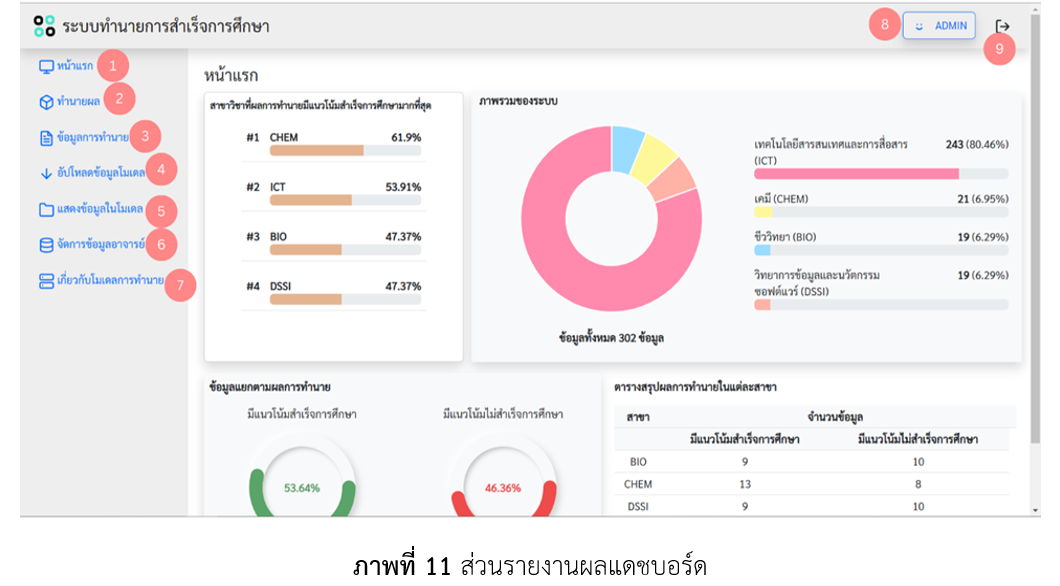ระบบพยากรณ์การสำเร็จการศึกษาของผู้เรียนด้วยเทคนิคป่าสุ่ม
Main Article Content
บทคัดย่อ
ญหาผลการเรียนที่อยู่ในระดับค่อนข้างน้อยและการตกออกเพิ่มขึ้น ทำให้อัตราการคงอยู่ของนักศึกษาลดลง ทำให้ส่งผลกระทบในหลายด้าน เช่น สูญเสียเวลา ค่าใช้จ่าย และโอกาสในการได้งาน การเตรียมความพร้อมและการวิเคราะห์ข้อมูลผู้เรียนจึงเป็นสิ่งสำคัญ งานวิจัยนี้มีวัตถุประสงค์เพื่อ 1) ศึกษาและสร้างแบบจำลองการพยากรณ์ประสิทธิภาพการเรียนรู้ของนักศึกษา 4 สาขาวิชา ได้แก่ วิทยาการข้อมูลและนวัตกรรมซอฟต์แวร์ เทคโนโลยีสารสนเทศและการสื่อสาร เคมี และจุลชีววิทยา คณะวิทยาศาสตร์ มหาวิทยาลัยอุบลราชธานี ด้วยเทคนิคป่าสุ่ม และ 2) พัฒนาระบบต้นแบบในรูปแบบเว็บแอปพลิเคชันเพื่อใช้งานแบบจำลองและสรุปผลด้วยจังโก้เฟรมเวิร์กและจัดเก็บข้อมูลในฐานข้อมูลโพสต์เกรสคิวเอล ชุดข้อมูลที่ใช้ในการสร้างแบบจำลองเป็นผลการเรียนจากทั้งโรงเรียนและมหาวิทยาลัยในอดีตของนักศึกษา 4 สาขาวิชา คณะวิทยาศาสตร์ ในปีการศึกษา 2560-2564 จำนวน 1,336 คน โดยพิจารณาข้อมูล 11 ปัจจัย ได้แก่ สาขาวิชาการศึกษา เกรดเฉลี่ยสะสมปีแรกในมหาวิทยาลัย ผลการเรียนใน 8 กลุ่มสาระหลัก ได้แก่ กลุ่มวิชาภาษาไทย คณิตศาสตร์ วิทยาศาสตร์ สังคมศึกษา ศาสนา และวัฒนธรรม ศิลปะ การงานอาชีพและเทคโนโลยี ภาษาต่างประเทศ และเกรดเฉลี่ยในโรงเรียน ผลการวิจัยแบบจำลองต้นแบบของสาขาวิชา วิทยาการข้อมูลและนวัตกรรมซอฟต์แวร์ เทคโนโลยีสารสนเทศและการสื่อสาร เคมี และจุลชีววิทยา สามารถพยากรณ์ผลการเรียนรู้ของผู้เรียนโดยมีค่า F1-measure เท่ากับ 88.02% 86.18% 84.04% และ 85.18% ตามลำดับ ดังนั้นการนำระบบที่พัฒนาขึ้นนี้ไปใช้จะมีประโยชน์ต่อผู้เรียน ผู้สอนในสาขาวิชา และสถาบันการศึกษา เพื่อใช้ในการวางแผนและการจัดการสอนให้เหมาะสมและมีประสิทธิภาพมากยิ่งขึ้น
Article Details

อนุญาตภายใต้เงื่อนไข Creative Commons Attribution-NonCommercial-NoDerivatives 4.0 International License.
วารสารวิทยาศาสตร์และวิทยาศาสตร์ศึกษา (JSSE) เป็นผู้ถือลิสิทธิ์บทความทุกบทความที่เผยแพร่ใน JSSE นี้ ทั้งนี้ ผู้เขียนจะต้องส่งแบบโอนลิขสิทธิ์บทความฉบับที่มีรายมือชื่อของผู้เขียนหลักหรือผู้ที่ได้รับมอบอำนาจแทนผู้เขียนทุกนให้กับ JSSE ก่อนที่บทความจะมีการเผยแพร่ผ่านเว็บไซต์ของวารสาร
แบบโอนลิขสิทธิ์บทความ (Copyright Transfer Form)
ทางวารสาร JSSE ได้กำหนดให้มีการกรอกแบบโอนลิขสิทธิ์บทความให้ครบถ้วนและส่งมายังกองบรรณาธิการในข้อมูลเสริม (supplementary data) พร้อมกับนิพนธ์ต้นฉบับ (manuscript) ที่ส่งมาขอรับการตีพิมพ์ ทั้งนี้ ผู้เขียนหลัก (corresponding authors) หรือผู้รับมอบอำนาจ (ในฐานะตัวแทนของผู้เขียนทุกคน) สามารถดำเนินการโอนลิขสิทธิ์บทความแทนผู้เขียนทั้งหมดได้ ซึ่งสามารถอัพโหลดไฟล์บทความต้นฉบับ (Manuscript) และไฟล์แบบโอนลิขสิทธิ์บทความ (Copyright Transfer Form) ในเมนู “Upload Submission” ดังนี้
1. อัพโหลดไฟล์บทความต้นฉบับ (Manuscript) ในเมนูย่อย Article Component > Article Text
2. อัพโหลดไฟล์แบบโอนลิขสิทธิ์บทความ (Copyright Transfer Form) ในเมนูย่อย Article Component > Other
ดาวน์โหลด ไฟล์แบบโอนลิขสิทธิ์บทความ (Copyright Transfer Form)
เอกสารอ้างอิง
Alboaneen, D., Almelihi, M., Alsubaie, R., Alghamdi, R., Alshehri, L. and Alharthi, R. (2022). Development of a web-based prediction system for students’ academic performance. Data, 7(2), 21.
Amazon Web Services. (2024). What is Django?. Retrieved February 22, 2024, from AWS: https://aws.amazon.com/th/what-is/django/
Brownlee, J. (2020). 4 Types of Classification Tasks in Machine Learning. Retrieved February 22, 2024, from Machine Learning Mastery: https://machinelearningmastery.com/types-of-classification-in-machine-learning/?fbclid=IwAR2gbsHUbY_YUdt4l4RBvHAQyze3YlMYVsnyjq99ZJW36lb5qjMISvYcZ2A
Data Innovation and Governance Institute. (2022). Understand in 5 minutes! What is a Classification Model? (in Thai). Retrieved February 22, 2024, from DIGI: https://digi.data.go.th/blog/what-is-classification-model/
Hailu, B. and Murty, M. N. (2019). Performance analysis and prediction of students using random forest algorithm. International Journal of Engineering Research and Technology, 12(2), 129-136.
Han, J., Kamber, M. and Pei, J. (2012). Data Mining: Concepts and Techniques. Melbourne: Elsevier Inc.
Jamjumrat, C. (2022). What Is A Decision Tree?. Retrieved 22 February 2024, from borntoDev: https://www.borntodev.com/2022/09/15/รู้จักกับ-decision-tree/
Kaensar, C. and Wongnin, W. (2023). Predicting new student performances and identifying important attributes of admission data using machine learning techniques with hyperparameter tuning. Eurasia Journal of Mathematics, Science and Technology Education, 19(12), em2369.
Kaensar, C. and Wongnin, W. (2024). Enhancing prediction of student learning success in higher education using deep learning (in Thai). Journal of Science and Science Education, 7(1), 21–36.
Kongchai, P., Hiranpongsin, S. and Ditcharoen, N. (2024). Creating a prediction model for prospective university student admissions during the COVID-19 pandemic situation: A case study of the faculty of science at Ubon Ratchathani university (in Thai). The Journal of King Mongkut's University of Technology North Bangkok, 34(2), 1–10.
Li, H. and Zhao, C. (2020). Research on the Application of Machine Learning in Web Application Development. In Proceedings of Smart Grid and Electrical Automation International Conference 2020, (pp. 478-482). Zhangjiajie: China.
Mekha, P., Musikong, P., Palakong, N., Pramokchon, P. and Kasemsumran, P. (2023). Performance comparison of image classification models for corn leaf disease (in Thai). Maejo Information Technology and Innovation Journal, 9(2), 1–16.
Nachouki, M., Elfadil, A.M., Mehdi, R. and Naaj, M (2023). Student course grade prediction using the random forest algorithm: Analysis of predictors' importance. Trends in Neuroscience and Education, 33, 100214.
Naresuan University Publishing House. (2023). Data Mining (in Thai). Retrieved February 22, 2024. from NUPRESS: https://www.nupress.grad.nu.ac.th/data-mining/#3--classification
Riansut, W. (2016). Factors influencing on grade point average of thaksin university’s undergraduate students (in Thai). Science Journal of Phetchaburi Rajabhat University, 13(2), 23-38.
Shalev-Shwartz, S. and Ben-David, S. (2014). Understanding Machine Learning. Cambridge: Cambridge University Press.
Shou, Z., Xie, M., Mo, J. and Zhang, H (2024). Predicting student performance in online learning: a multidimensional time-series data analysis approach. Applied Sciences. 14(6), 1-16.
Soontranon, N. (2023). Evaluation Metrics for Classification Model (in Thai). Retrieved February 22, 2024, from NERD: https://www.nerd-data.com/classification-metrics/
Valverde-Berrocoso, J., Acevedo-Borrega J. and Cerezo-Pizarro, M. (2022), Educational technology and student performance: a systematic review. Frontiers in Education, 7(1), 1-13.
Wongsakoonkan, W., Ju-Ngam, B., Komuttiban, P., Klunbut, P. and Alongkorn, V. (2021). A comparison of learning achievement of the undergraduate students admitted through direct examination and admission case study: department of occupational health and safety, faculty of science and technology: Valaya Alongkorn Rajabhat University Under the Royal Patronage (in Thai). Valaya Alongkorn Review Journal, 11(1), 1-12.


